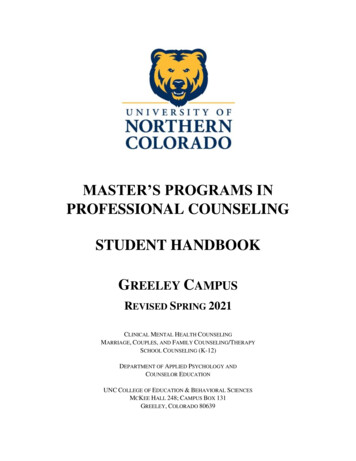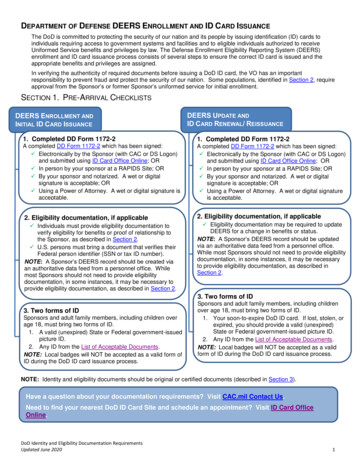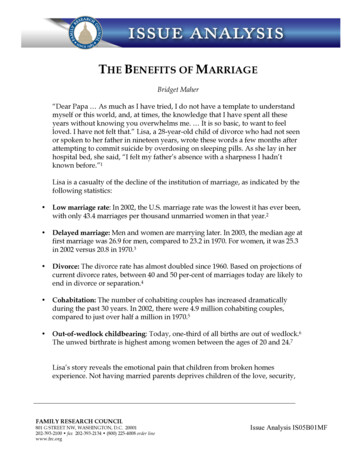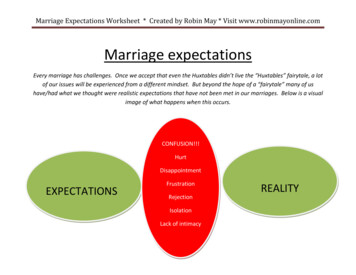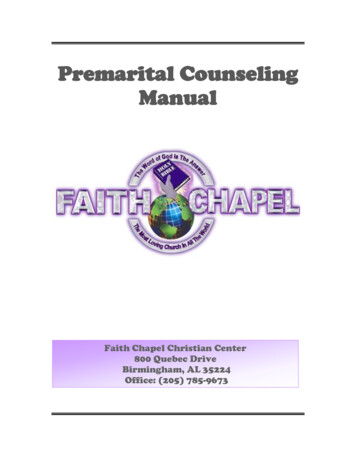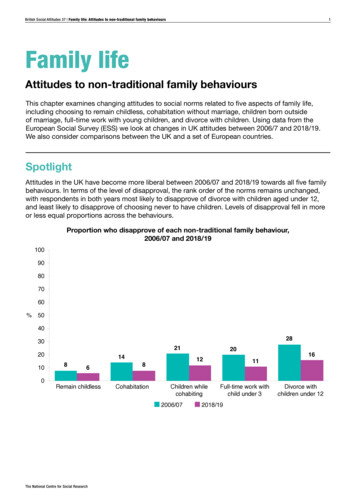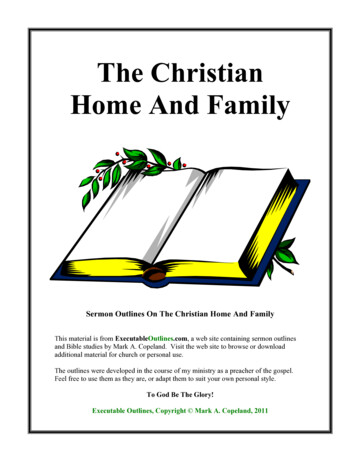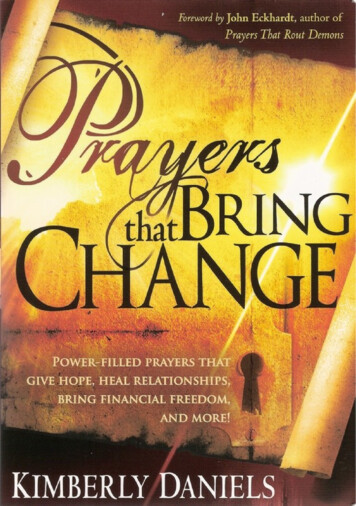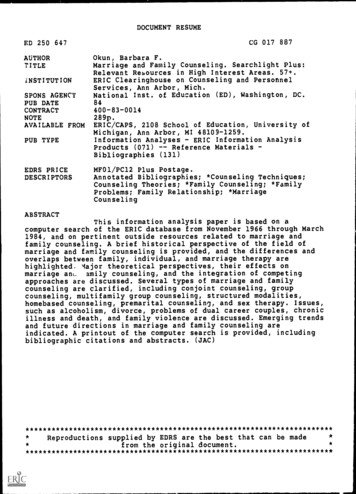
Transcription
DOCUMENT RESUMECG 017 887ED 250 647AUTHORTITLEINSTITUTIONSPONS AGENCYPUB DATECONTRACTNOTEAVAILABLE FROMPUB TYPEEDRS PRICEDESCRIPTORSOkun, Barbara F.Marriage and Family Counseling. Searchlight Plus:Relevant Resources in High Interest Areas. 57 .ERIC Clearinghouse on Counseling and PersonnelServices, Ann Arbor, Mich.National Inst. of Education (ED), Washington, DC.84400-83-0014289p.ERIC/CAPS, 2108 School of Education, University ofMichigan, Ann Arbor, MI 48109-1259.ERIC Information AnalysisInformation AnalysesReference Materials Products (071)Bibliographies (131)MF01/PC12 Plus Postage.Annotated Bibliographies; *Counseling Techniques;Counseling Theories; *Family Counseling; *FamilyProblems; Family Relationship; *MarriageCounselingABSTRACTThis information analysis paper is based on acomputer search of the ERIC database from November 1966 through March1984, and on pertinent outside resources related to marriage andfamily counseling. A brief historical perspective of the field ofmarriage and family counseling is provided, and the differences andoverlaps between family, individual, and marriage therapy arehighlighted. 4ajor theoretical perspectives, their effects onamily counseling, and the integration of competingmarriage ank,approaches are discussed. Several types of marriage and familycounseling are clarified, including conjoint counseling, groupcounseling, multifamily group counseling, structured modalities,homebased counseling, premarital counseling, and sex therapy. Issues,such as alcoholism, divorce, problems of dual career couples, chronicillness and death, and family violence are discussed. Emerging trendsand future directions in marriage and family counseling areindicated. A printout of the computer search is provided, includingbibliographic citations and abstracts. **************************Reproductions supplied by EDRS are the best that can be madefrom the original ******************************
57 4.L.C1MARRIAGE AND FAMILYCOUNSELINGC\JCZ,Barbara F. OkunITAPSRelevant Resources in High Interest AreasU.S. DEPARTMENT OF EDUCATIONNATIONAL INSTITUTE OF EDUCATIONEOM:A IONAL RESOURCES INFORMATIONCENTER 'ERIC!do( umrnt has been reproduced asre( oi veil from the person or organization11)1,,(m(1111.111'10 it( /1,11196'1 PI4Vn been made to improverentielliction qualify(1),POMP: of view or opinions staled in this decoit1411 In not necessarily fPreSelit Off Irial NitAV,PO5111011 or policyrERicl 3
The NationalInstitute ofEducationThis publication was prepared with funding from the NationalInstitute of Education, U.S. Department of Education undercontract no. 400 83.0014. The opinions expressed in this report donot necessarily reflect the positions or policies of NIE or theDepartment of Education.ERIC COUNSELING AND PERSONNEL SERVICES CLEARINGHOUSESchool of EducationThe University of MichiganAnn Arbor, Michigan 48109Published by ERIC/CAPS
MARRIAGE AND FAMILY COUNSELINGBarbara F. OkunSearchlight Plus: Relevant ResourcesIn High Interest Areas. 57 AN INFORMATION ANALYSIS PAPERBased on a computer search of the ERIC databaseNovember 1966 through March 1984EDUCATIONAL RESOURCES INFORMATION CENTERCOUNSELING AND PERSONNEL SERVICES CLEARINGHOUSEI984
INTRODUCTORY NOTEA Searchlight Plus is an information analysis paper based on a computer search of theERIC database from 1966 to the present and on pertinent outside resources. The paper reviews,analyzes and interprets the literature on a particular counseling topic and points out theimplications of the information for human services professionals. The purpose of theSearchlight Plus is to alert readers to the wealth of information in the ERIC system and tocreate a product that helping professionals will find practical and useful in their own work.Included with the paper is a printout of the computer search, which provides completebibliographic citations with abstracts of ERIC journal articles and microfiche documents.Journal articles cited in the paper are identified by EJ numbers and are available in completeform only in their source journals. Microfiche documents are cited by ED numbers and areavailable in paper copy or microfiche form through the ERIC Document Reproduction Service.(Details are provided on the colored cover sheets at the back of the publication.) Documentsmay also be read on site at more than 700 ERIC microfiche collections in the United States andabroad.
TABLE OF CONTENTSIntroduction and PurposeIHistorical Perspective2Family vs. Individual vs. Marriage Therapy2Theoretical Approaches4Types of Marriage and Family Counseling8Presenting Issues and Effective Approaches14Emerging Trends and Future Directions28Additional References,ii31
MARRIAGE AND FAMILY COUNSELINGBarbara F. Okun, Ph.D.Northeastern University, BostonINTRODUCTION AND PURPOSEMarriage and family counseling has become a significantly large, recognized clinical/counseling specialty in thepast decade. The professional literature of the past fifteen years reflects this development. In a review of maritaland family therapy, Olson et al. (EJ 238 230) asserts that marital and family therapy has gained credibility in the pastdecade and has now emerged as a viable treatment approach for most mental health problems. While marital andfamily therapy is not the only treatment choice, it is certainly a major modality to consider.Today, there are several professional journals (Family Process, American Journal of Family Therapy, Journal ofMarital arid Family Therapy, Journal of Marriage and Family Counseling, Family Coordinator) devoted solely to thestudy of marriage and family counseling. Other publications in the fields of social work, counseling, psychiatry andpsychology often focus special editions on marriage and family counseling. The health professions also increasinglyinclude the study of marriage and family influences on illness (and vice versa) in their professional training andliterature.The purposes of this paper are several: (I) to provide a brief historical perspective of the field of marriage andfamily counseling; (2) to highlight the differences and overlaps between family, individual and marriage therapy; (3) todiscuss the major theoretical perspectives; (4) to clarify the types of counseling and the typical presenting issues; and(5) to indicate emerging trends and future directions for marriage and family counseling.
HISTORICAL PERSPECTIVEFamily therapy evolved from the traditions of individual psychotherapy. The impetus came from the frustrationthat therapists experienced in applying individual psychotherapeutic strategies and techniques to hospitalizedschizophrenic and delinquent populations. From early work on communications came the notion that the symptomcould not be considered as separate from the system in which the symptom carrier lived. How communications andstructures contribute to symptom formation and maintenance became a primary research focus of the early familytherapy theorists.Marriage therapy evolved more from the work of pastoral counselors and social workers. As a result of seeingcouples together, they began to recognize the viability of focusing on the relationship itself rather than on twoindividuals who happen to be in treatment together.Today, the types of human service professionals involved in marriage and family counseling vary. Members ofthe clergy, counselors, psychologists, social workers, nurses and psychiatrists are among those who offer theseservices.Their training and background differ enormously, as do he ranges of their services (EJ 223 062), and amajor professional issue has developed concerning their training and credentialing. Presently, there 's a trend towardsconformance to the standards of the American Association of Marriage and Family Therapy (AAMFT), which is thenational official credentialing agency for marriage and family therapists. Some states provide specialized credentialing; other states presume that any licensed mental health provider has the skills and knowledge to practice thisform of treatment and, therefore, require no specialized credential.FAMILY VS. INDIVIDUAL VS. MARRIAGE THERAPYThe family therapy perspective regards problems and dysfunction as emanating from the family system ratherthan from the intrapsychic problems of any one individual within the family. In-lividual symptoms are seen as21011
reflections of stress within a larger family system. This stress may occur when a family or couple is unable tonegotiate a developmental passage, such as the oldest child's entrance into school or the onset of adolescence, orwhen a nondevelopmental crisis occurs, e.g., illness, unemployment or divorce. It is this systems viewpoint whichdifferentiates individual and family therapy perspectives. Most individual therapies focus on insight, fantasies,history, and the client-therapist relationship, de-emphasizing, if not ignoring, the actual interactional processesbetween the client and his or her social environment. In contrast, family therapy focuses an the communicationprocesses, power balances and imbalances, influence processes, structures for conflict resolution, and the currentfunctioning of the family as a system.The goal of family therapy is to effect change not only in an individual, but also in the structure of the familyand the sequences of behavior among its members (Okun & Rappaport, 1980). An important tenet of family systemstherapy is that change in the system will affect individuals' attitudes, feelings and behaviors which will, in turn,further change the system. This continuous, fluid, circular feedback process allows growth and change. When systemsbecome stuck, individual members manifest symptoms.The processes and stages of therapy with family systems are also significantly different from those of therapywith individuals (EJ 142 715). Family therapy requires more active, directive interventions and more focus on familymember relationships than on the client-therapist relationship.Marriage therapy is viewed today as an integral component of family therapy, although they were onceconsidered separate specialties. Marriage therapy focused directly on the marital relationship as well as on theindividuals and contributed the notion of "conjoint" therapy to the field of psychotherapy well before family therapyhegan to evolve (EJ 030 943). Most of the literature of the 1970s and 1980s considers marriage therapy within thecontext of family therapy, acknowledging that the spouses' families of origin, as well as their children, have an impacton marital issues, and vice versa. This merging of specialties is also reflected in the membership requirements ofprofessional associations for training and supervised experience in both marriage and family counseling.The one comprehensive specialty is often termed "marriage and family therapy" or "counseling." The separateterms "marriage counseling," "family counseling," "marriage/marital they" and "family therapy" overlap and31213
distinctions, if any, vary according to the use of the terms. The journals and professional associations are more likelyto use the term "marriage and family therapy." In this paper, the terms "counseling" and "therapy" will be usedinterchangeably.THEORETICAL APPROACHESIt is important to keep in mind the development of theoretical counseling perspectives in the mid-I900s. Priorto the 1950s, the predominant counseling and psychotherapy approach was based on the psychodynamic theoreticalperspective. In the 1950s, the client-centered, existential approach emerged as a powerful alternative to the moretraditional medical model based on the psychodynamic view; this created divisions within and among the mentalhealth professions.During the 1960s, the cognitive, behavioral and transactional theoretical perspectives gained prominence andthe competition between these different "schools" led to a confused and often dogmatic search for the "rightapproach." The 1970s saw the systems and transpersonal theoretical perspectives emerge as alternative views.Recently, the counseling literature reflects a more eclectic trend that attempts to integrate these disparate perspectives.Effects on Marriage and Family CounselingMarriage counseling, evolving from the psychodynamic perspective, was also influenced by the theoreticaldevelopments just mentioned. Thus, the theoretical perspectives of marriage counseling were modifications andadaptations of existing counseling theories. In the 1950s, family therapy evolved from the broad framework ofgeneral systems theory, which, heretofore, had not been applied to humans, and this viewpoint was in strong opposi-tion to the prevailing psychodynamic and client-centered views. Counselors and therapists in the late 1950s and the1960s were polarized, each group striving to gain prominence in professional circles. The major conceptual difference41415
between the psychodynamic or client-centered perspectives and the systems perspective is the focus, which shiftsfrom what goes on inside an individual to the study of relationships between individuals. All individual behavior isviewed by systems theorists as deriving its meaning and motives from interpersonal behavior within a larger context.A review of the marriage and family counseling literature from 1966-1983 reflects the proliferation of differenttheoretical perspectives. By the late 1960s, there are articles favoring each of these viewpoints, i.e., psychodynamic,existential, behavioral, cognitive and systems. Each article seeks to promote a unilateral theoretical viewpoint inopposition to all others.The early literature does not reflect the merger of marital and family counseling. The marriage counselingliterature emphasizes the psychodynamic, client-centered and behavioral views. The family counseling literature isbased more on a communications or structural emphasis, stemming irom the rapidly developing family systems theoryof Sat:r, Jackson, Haley, Minuchin, Bowen and Ackerman.What is noteworthy in the 1980s is that more recent articles suggest reconsideration of the psychodynamic,behavioral and existential perspectives and attempt to integrate these views into the evolving systems theoreticalperspective. Also, the current systems theoretical perspective is moving from a strong communications emphasis todifferentiated structural and strategic approadies.Integration of Competing ApproachesGurman obsemves that "a rapprochement among competing methods and views of marital and family therapyconstitutes the major creative challenge for the field in the decade of the 1980s" (EJ 225 016). The 1968-1983literature is predominantly based on the following modalities: psychodynamic (EJ 270 944, EJ 249 667, EJ 209 243);Adlerian (EJ 243 598, EJ 191 976, ED 079 660); systems (EJ 249 663, EJ 197 571, EJ 178 971); communication(EJ 264 120, EJ 253 507, EJ 236 112, EJ 185 21), ED 166 614); structural (EJ 282 489, EJ 265 607, EJ 242 068,EJ 220 365, rE.J 193 697, EJ 178 971, EJ 177 225, EJ 175 344, EJ 163 906); client-centered (EJ 184 588); cognitive(EJ 261 101, EJ 238 305, EJ 227 400, EJ 184 617, EJ 163 906); and behavioral (EJ 277 731, EJ 248 231, EJ 223 061,EJ 169 348, EJ 163 906, ED 225 059). The 1980 articles reveal an emerging trend of an integrative view, combining1657
aspects of most of the aforementioned views. Some articles focus on integrating different schools of the traditionalcounseling theories, i.e., cognitive and existential, behavioral and cognitive (EJ 282 495, EJ 270 943, EJ 261 101,EJ 253 464, EJ 242 061, EJ 178 966, EJ 177 225, EJ 122 291, EJ 090 997).Many articles discuss the need for reconsidering the integration of the psychodynamic understanding of maritaland family process, with behavioral methodology for producing therapeutic changes within the systems perspective(EJ 282 495, EJ 270 944, EJ 270 943, EJ 262 058, EJ 259 171, EJ 245 391, EJ 175 317). For example, Mallouk(EJ 270 944) points out the importance of the object-relations view in understanding an individual's behavior w'thinthe family system. Only by understanding the roles and relationships of the parents with their siblings and parents intheir respective family of origin can we understand their relationships in it ie current family system. Another exampleis presented by Walsh (EJ 259 171), who also blends relationship concepts with the intrapsychic component into anintegrative model.The most common17 postulated integration is among modern psychoanalytic approaches, systems theory,communications theory and behavioral approaches. Grunebaum and Chasin (1982) present an integrative model basedon (I) an historical perspective, acknowledging that family members are shaped by past forces and events, someknown and some unknown; (2) an interactional perspective, or the behavioral sequences and family structuresoccurring in the here and now; and (3) an existential perspective, or the subjective quality of each individual'sexperience in the family, as well as the therapist's experience as an outsider entering the system. These therapistsbelieve that all three perspectives are equally important in assessing and treating families. This type of integration issupported by Levant (EJ 286 411, 1980), who classifies the major family therapy theorists into the above categoriesand also presents three general types of diagnostic models based on this classification scheme (process/structural,historical and experiential). L'Abate and Frey (1981) also reconsider the classification of theories of family therapywith their proposal of an Emotionality-Rationality-Activity model, drawing from affective, cognitive and behavioraltheories.A recent article by Lebow (1984) describes the advantages and pitfalls of integrating theoretic-di approaches tofamily therapy. Some of the advantages include: (I) a broad theoretical base paying homage to biology, intrapsychic8619
factors, cognitions, behavior and interpersonal variables; (2) a greater flexibility in treatment possibilities; (3) broaderapplicability to clients and broader training possibilities. The pitfalls include: (I) a lack of an integrated theoreticalbasis (Lebow cautions against the confusion of integration and sloppy eclecticism); and (2) ultra-complexity oftheories, resulting in a striving towards an unattainable utopia. In other words, one risks oversimplification orovercomplication without a caretully constructed theoretical foundation. Fraser (1982) suggests that the conceptualintegration of different approaches may be possible at a high theoretical level but that the practical integration by apractitioner may be difficult due to different units of analyses. He suggests that the distinctions between thepsychodynamic and systems models are more on levels of theoretical conceptualizations and clinical techniques thanon the notions of what constitutes a healthy family or goals and objectives of family treatment.Most of the salient aspects of family therapy cut across the different schools of training. There does riot seemto be disagreement as to what healthy family functioning is or what the overall goals of treatment should be. Moreattention probably needs to be paid to the similarities rather than the differences between the various schools oftraining. The underlying philosophical concepts are not as different as the proponents would have us believe.It is difficult to research the outcomes of different types and modalities of therapy, whether individual, group orfamily. None of the research on outcome reports a significant advantage to any one school, although the behaviorallyoriented approaches are cited more in outcome studies than other approaches.Foster and Hoier (EJ 269 519) report that behavioral and systems family therapies share functional views ofproblem behaviors and interactive sequences. While the behavioral theories utii:ze more molecular analyses ofprocesses than does systems theory, the targets and methods of interventions have many commonalities. It may bethat these molecular analyses lend themselves to outcome studies more readily than do other theoretical approaches.It is also important to note, however, that the behavioral and systems theory approaches diverge in a number ofways: (I) the locus of intervention (contingency sequences versus systemic structures); (2) explanations of interactionmechanisms and failure to change; (3) approaches to the maintenance of therapeutic gain; and (4) the integration ofassessment with treatment goals and methods.20721
When one discusses theoretical perspectives, it is important to differentiate between views of family functioning, family change, and therapeutic approaches. Green and Koleozin (El 262 858) point out the tenuous relationship between family therapists' belief systems and action systems. In a study of 1000 AAMFT therapists, theyfound a greater overlap of therapeutic styles than of theoretical assumptions, indicating that whereas constructs maybe clearly articulated, the interventions derived from these theoretical constructs are less clearly articulated. Whenwe consider the integration of theoretical perspectives, we need to be clear about whether we are referring toconstructs or interventions. Most of the clinical applications of family systems theory utilize existential, cognitiveand behavioral intervention strategies.It is evident from this review that, in terms of theoretical constructs, a general systems perspective predominates in the field of marital and family therapy. The systems perspective influences family assessment and theformulation of treatment objectives. The greatest variability occurs in treatment interventions, which are oftenadapted from individual therapy schools. There is some variability among therapists in their emphasis on historical,interactional and existential perspectives, and this variability may reflect either belief or action systems of thetherapists. The general trend towards theoretical integration seems nevertheless likely to continue throughout the1980s.TYPES OF MARRIAGE AND FAMILY COUNSELINGThe most frequently cited types of marriage and family counseling are-conjoint and group counseling. Othertypes include multifamily group counseling, structured modalities, marital therapy, homebased counseling, premaritalcounseling, and sex therapy.22823
Conjoint CounselingConjoint family counseling means that all members of the nuclear family who live together are seen in the samesession. As stated earlier, this emphasis on the entire family as the unit of treatment is what differentiates familycounseling from individual counseling. Currently, however, the unit of treatment is not regarded as important as thefamily theory perspective, and many counselors work from a systems perspective with the whole family, withindividuals or with other subsystems (Okun & Rappaport, 1980). The literature reflects a variety of views about thissituation. West and Kirby (EJ 242 037) believe that the interdependence of family members is the critical element inthe family group therapy process and stress the need to see the family as a group. Other writers in the rehabilitationfield also believe that the rehabilitation process is greatly enhanced by counseling strategies involving the family(EJ 221 792, EJ !tv7 492, ED 205 849). Rosenberg (EJ 233 896) cites the value of working with sibling subsystems tohelp children reF lye conflicts and remove interferences to mutually supportive relationships. In recent years, therehas been quite a it of latitude in units of treatment and types of intervention strategies utilized.Group CounselingGroup counseling for special interest groups is becoming increasingly prevalent. The group may consist of oneor both parents, children, siblings or parent/child subsystems. This type of counseling deals with family problems butprovides support and feedback from other families with similar concerns. For example, Aranoff and Lewis(EJ 204 274) describe an innovative group experience for couples expecting their first child. In this project, thepurpose was to stimulate couples to become aware of their communications and support systems as necessary buildingblocks for healthy family emotional development.Another example of this type of group approach is described by Cohen (EJ 285 268) who found that a groupapproach for working with families of the elderly encouraged information sharing, support, and working throughemotional and practical problems associated with care of the elderly. As we become more concerned with thecaretaking issues of multigenerational families, more attention is being paid to effective ways of providing counselingservices to relatives of dependent older adults (EJ 268 029, EJ 259 065, ED 218 567, ED 198 455, ED 156 933).249
Problems associated with aging include physical changes and the emotional and psychological demands accompanyingchanges in home, health, financial, and relationship status.Other articles describe group approaches for parents of leukemic children (EJ 098 341, EJ 081 8Li, for fosterparents (ED 191 191), for parents of acting-out adolescents and handicapped children (EJ 264 120, EJ 191 976,EJ 060 509, ED 200 841). For example, Reynolds and others (ED 203 246) describe the family-theme group approachto working with schizophrenics. This process of theme-centered assessment and skills-training format was found to bean effective method for maintaining schizophrenic clients in the community rather than in an institution.Multifamily Group CounselingMultifamily group counseling is also reported in the literature. This group consists of two or more wholefamilies. Gould (EJ 248 237) studied how family members utilized the intrafamily interaction more than he interfamily mode. Either mothers or fathers tended to dominate with the interfamily mode. When dominant, motherstalked more to other mothers, while fathers talked mostly to children or fathers. This indicates that spouses are notas likely to communicate directly with each other in multifamily groups. In this vein, Anderson (EJ 092 373) discussesthe unique advantages for educating and strengthening families in groups. There appears to be shifting parentaldominance patterns in multifamily group therapy as opposed to intrafamily therapy. Some of the multifamily therapyis based on common themes, such as reconstituted families, type of illness or handicap or stage of family development. There is potential for increased learning, support and problem solving.Group and multifamily group counseling have evolved naturally from the school-based parent education modelsbegun in the late 1960s and early 1970s (EJ 089 524, EJ 054 184, ED 193 570). Larson (EJ 054 184) found evidencethat working with parents in group settings affects family communications in a positive manner. Likewise, Simon(EJ 229 791) found that values clarification in family groups is a practical and realistic way to help families settleconflicts. School counselors and psychologists have found parent groups to be effective ways of reaching a largenumber of constituents. Attention needs to be directed, however, towards developing effective approaches forengaging the participation of "hard to reach" parent populations. Typically, the parents who really need help are not261027
the ones to attend parent group meetings at school.Sutton (ED 193 570) suggests that small long-term groups withco-leadership appear to be th,s most successful medium for working with such "hard to reach" parents, once they areengaged in attending such group meetings.Structured ModalitiesMuch of the marriage counseling reported in the literature concerns structured communication models, marriageenrichment and marriage encounter groups (EJ 270 947, EJ 265 610, EJ 265 541, EJ 259 058, EJ 253 464, EJ 245 410,EJ 238 308, EJ 165 636, EJ 160 228, EJ 146 128, EJ 142 717, EJ 127 439).These models, consisting of sequencedprogram learning, were all reported by the client couples to produce satisfactory change; but replicated research isnecessary before any particular model can be considered to be more effective than another. Most of these structuredmodalities occur in groups. Such modalities are viewed as preventive, developmental and educative rather than astherapeutic or crisis oriented. They are intended for general applicability rather than idiosyncratic issues.Marital TherapyIn a comparative analysis of alternative marital therapies, Bornstein and others (EJ 282 495) found thatbehavioral and systems approaches were rated more acceptable than analytic or eclectic therapies. Behavioral andcognitive marital therapies are increasingly described in the lit.trature (EJ 261 101, EJ 175 344, EJ 163 906,EJ 122 291, EJ 012 997). Cognitive self-disclosure, behavioral contracts, modeling, cognitive restructuring, problemsolving and communication skills are the major foci of marriage counseling. Since we have no real theory of what amarriage should be or how one can measure what it is, research in this area is indeed tenuous. Arias (ED 222 845)calls for further research on cognitive variables, such as the relationship between perceptual accuracy and maritalsatisfaction, between expectations, reasons for marriage and actual marital experience. Fichten (EJ 279 227) pointsout that we do not have definitive conclusions about how the communication behaviors of happy and distressed couplesdiffer and that most of the rating scales and feedback mechanisms used in marital therapy research are very subjective. It may be that commitment of the couple and attention to the couple and their issues are the two major2829
variables affecting the outcome of couples therapy (ED 225 081). Attention also needs to be given to the impact ofexternal stress factors, such as political, economic and cultural variables, on marital satisfaction.Homebased CounselingHomebased family counseling see
Marital arid Family_Therapy, Journal of Marriage and Family Counseling, Family Coordinator) devoted solely to the study of marriage and family counseling. Other publications in the fields of social work, counseling, psychiatry and psychology often focus special editions on marriage and family coun
